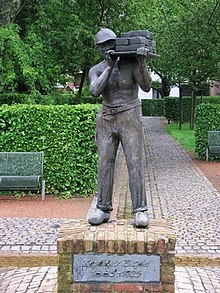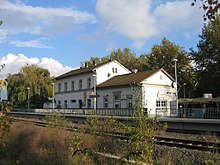Chapels (Grevenbroich)
|
Chapels
City of Grevenbroich
Coordinates: 51 ° 7 ′ 36 " N , 6 ° 37 ′ 20" E
|
|
|---|---|
| Area : | 4.54 km² |
| Residents : | 6833 (Dec. 31, 2018) |
| Population density : | 1,506 inhabitants / km² |
| Incorporation : | 1st January 1975 |
| Postal code : | 41516 |
| Area code : | 02182 |
|
Entrance sign in the north of Kapellen
|
|
Kapellen , also Kapellen-Erft, is the second largest district of the city of Grevenbroich in the Rhine district of Neuss in North Rhine-Westphalia .
The district of Kapellen includes the districts of Gilverath , Gruissem (only south-western part), Neubrück , Tüschenbroich and Vierwinds . Kapellen has 6,636 inhabitants on an area of 4.536 km² (information from the city of Grevenbroich, as of December 31, 2016).
location
The place is in the triangle Cologne - Düsseldorf - Mönchengladbach . It borders on the town of Hemmerden in the west, on the town of Wevelinghoven in the south and on the town of Hülchrath in the east . Neuss- Holzheim is to the northeast of Kapellen .
The Erft flows through chapels .
history
According to unconfirmed reports, chapels can be considered an early clearing site in the 9th century, for which the building of a house of worship was named. Who founded this building and with it the settlement is still unknown today.
The first written mention of Kapellen comes from the year 1155. At that time the place name was "Capellen", named after the "Capella St. Kosmos and Damian". From 1229 to 1794, Capellen belonged to the Count's Land in the Electoral Cologne Office of Hülchrath . In that year French troops occupied the place. The Erft has always been of economic importance as a driving force, for example for the Neubrück mill. In 1815 Capellen came to the Kingdom of Prussia and in 1816 as an independent municipality to the Grevenbroich district . In 1869, Capellen was connected to the important Düren – Neuss railway line with a stop .
It was not until 1910 that “Capellen” was renamed the current “Kapellen”. The Hemmerden Office was later created for administrative purposes , consisting of the communities Hemmerden and Kapellen / Erft and had its official seat in Kapellen since 1921. The last mayor was Heinrich Tups (CDU) and his deputy Wilhelm Krall (CDU). On January 1, 1975, the municipality of Kapellen lost its independence and was incorporated into the city of Grevenbroich.
New development area
Since 2004, over 500 single-family houses and apartments have been built in two construction phases between the A46 and the railway line in Kapellen. As a result, the number of inhabitants in chapels increased disproportionately compared to the other districts. A third and possibly fourth construction phase is to follow. The area incorrectly referred to by the real estate company as "Kapellen-Tal" is at the highest point in the district.
Population development
Kapellen is currently the district with the greatest increase in population per year.
|
|
|
Swell:
- 1816 and 1871: State Statistical Office North Rhine-Westphalia : Municipal Statistics of the State of North Rhine-Westphalia - Population Development 1816–1871
- 1905 to 1961: State Statistical Office North Rhine-Westphalia : Municipal statistics of the state of North Rhine-Westphalia - population development 1871–1961
- 1964 and 1974: Heinz Ohletz: 1929–1974 years of people initiatives in the greater Grevenbroich district, (1975)
- 1970: Federal Statistical Office (ed.): Historical municipality directory for the Federal Republic of Germany. Name, border and key number changes in municipalities, counties and administrative districts from May 27, 1970 to December 31, 1982 . W. Kohlhammer, Stuttgart / Mainz 1983, ISBN 3-17-003263-1 , p. 294 .
- from 2005: information from the city of Grevenbroich
religion
Catholic Church
The Catholic Church of Kapellen / Erft was first mentioned in 1229. It was an own church of St. Apostles in Cologne. The patronage was then transferred to the von Dyck gentlemen. The later civil parish of Kapellen originally consisted of two medieval parishes : on the one hand St. Clemens in Kapellen and on the other hand Johann Baptist in Gilverath. The two places were assigned to the land deans Bergheim and Neuss. In 1804 a new division was created.
Culture and leisure
In addition to the sports clubs and associations, numerous other associations are based in chapels. Examples include:
- Bürger-Schützen-Verein 1936 e. V. Kapellen / Erft
- Grenadier Corps Kapellen / Erft 1936 eV
- Citizens' initiative per bypass Kapellen-Wevelinghoven e. V.
- Heimatverein Kapellener-Jonge e. V.
- MSC (Motorsport Club) chapels
- NSU Quickli Club
- Save the Erftaue: Protection Association Habitat Kapellen-Wevelinghoven e. V.
- Skat club
Important events
- January: New Year's shooting for Grevenbroich rifle trains and grenadier festival
The New Year's shooting always takes place at the beginning of January on the Schützenplatz "Am Burghof". Organized by the Kapellen Grenadier Corps, all rifle clubs in the Grevenbroich area can take part and compete against each other in target shooting.
One day later, the Grenadier Corps band celebrates the traditional grenadier ball in the marquee on the Schützenplatz. The highlight of the event is the corps king couple's coronation. Here, too, the representatives of many Grevenbroich clubs are always invited, who, together with the local riflemen, ensure that the Grenadierfest Kapellen has firmly established itself as one of the largest corps festivals in the city.
- June: Schützen - and Heimatfest
The Schützen- und Heimatfest in Kapellen traditionally takes place on the first weekend in June from Friday to Tuesday. The big torchlight procession is to be emphasized, which sets itself in motion with all shooters and numerous large torches on Saturday evening after dark. Another impressive picture on Sunday is the great King's Parade followed by a rifle parade, where over 1000 riflemen and musicians march through the town to the marquee in various marching blocks.
The Schützenplatz with all its attractions and the large marquee is located on the “Am Burghof” site in Kapellen.
- August: rifle bivouac
Sports
Various sports clubs are based in Kapellen / Erft. The following are examples:
- SC 1911 Kapellen-Erft e. V.
- TV Jahn 06 eV Kapellen (Erft)
- TTC Kapellen-Erft 1962 e. V.
- Tennis Club Kapellen '84 e. V.
- ASV "Erftfreunde" 1937 e. V. Kapellen / Erft
Attractions
Rudolf Meschede's brick carrier in 1990
From 1885 until the beginning of the First World War , the building contractor Adam Rosen ran a ring kiln brickworks in Kapellen, which at times employed up to 60 workers. During the war period 1914–1918 the company was shut down due to the forced economy in the construction industry. Only in the years 1920–1922 was production slowly restarted. In 1926, however, the company was finally closed. The Kapellen community took over the site and made it accessible for general housing construction. The sculpture, which was designed by Peter Schlösser and Peter Winzen, is intended to remind of the brick bakers who worked in this brickworks.
The Peace Chapel
The Friedenskapelle is located in the Gilverath district of Kapellen. It was painstakingly rebuilt at the old location by the “Flotte Boschte” fighter train.
Hombroich missile station
During the Cold War , a NATO- operated NIKE missile station was built between Holzheim and Kapellen , which was occupied by Belgian and American units. After reunification and the end of the East-West conflict in 1990, the Hombroich missile station was shut down and is now operated as an open-air museum by the Insel Hombroich Foundation .
Facilities
- Day care center
- Voluntary fire brigade - "Kapellen" fire engine
- Four kindergartens
- Kapellen-Hemmerden Community Primary School (GGS), former secondary school
- Catholic parish church of St. Clement
- Evangelical St. John's Church
Infrastructure and traffic
With the increase in commercial space in the Kapellen industrial area, the already well-developed infrastructure is booming . Numerous small and large companies have settled in the Kapellen industrial area and take advantage of the immediate vicinity of the A 46 . In addition, the immigration boom to Kapellen continues due to the conversion of arable land into building land. A completely new local area will be created here in the coming years.
Numerous different shops mean that you are largely independent of other places. Furthermore, good transport links to both the A 46 and the Düren - Neuss railway line ensure that the surrounding cities can be reached quickly. Due to the strategically good location of Kapellen, the expansion of further commercial areas in the immediate vicinity of the motorway is being driven forward.
Rail transport
The Kapellen-Wevelinghoven station is served by the RB 39 (Düssel-Erft-Bahn) line. There is a connection to the cities of Düsseldorf , Neuss , Grevenbroich and Bedburg every half hour .
| line | Line designation | Line course | Clock frequency |
|---|---|---|---|
| RB 39 | Düssel-Erft Railway | Düsseldorf - Neuss - Kapellen-Wevelinghoven - Grevenbroich - Bedburg (Erf) | Every half hour (Mon-Fri), hourly (Sat-Sun) |
Bus transport
Kapellen is located in the area of the Verkehrsverbund Rhein-Ruhr and is served by the Rhineland bus service with six lines in addition to the rail traffic . There is also a line operated by Stadtwerke Neuss GmbH.
Kapellen is connected by the following bus routes:
Sons and daughters
- Walter Grasskamp , German art critic and sociologist
- Arnold Wolff , German architect and master builder in Cologne
- Tim Bergmann , German actor
- Ursula Kwasny , Mayor of Grevenbroich from 2009 to 2015
literature
- Chapels (Erft) . 2nd Edition. Geschichtsverein Grevenbroich , Grevenbroich 2001 ( contributions to the history of the city of Grevenbroich , 15).
- Heinz Ohletz: 1929–1974 years people initiatives in the greater Grevenbroich district . o. O. (1975)
Web links
- Overview of the chapels on the website of the city of Grevenbroich
Individual evidence
- ↑ Dates & Numbers - Chapels
- ^ Federal Statistical Office (ed.): Historical municipality directory for the Federal Republic of Germany. Name, border and key number changes in municipalities, counties and administrative districts from May 27, 1970 to December 31, 1982 . W. Kohlhammer, Stuttgart / Mainz 1983, ISBN 3-17-003263-1 , p. 294 .
- ^ Article on the new building area website of the Rheinische Post. Retrieved May 21, 2018.
- ↑ Urban development measure Grevenbroich-Kapellen
- ↑ Mayor's Gallery . (No longer available online.) In: www.grevenbroich.de. Archived from the original on August 11, 2016 ; accessed on August 11, 2016 . Info: The archive link was inserted automatically and has not yet been checked. Please check the original and archive link according to the instructions and then remove this notice.








